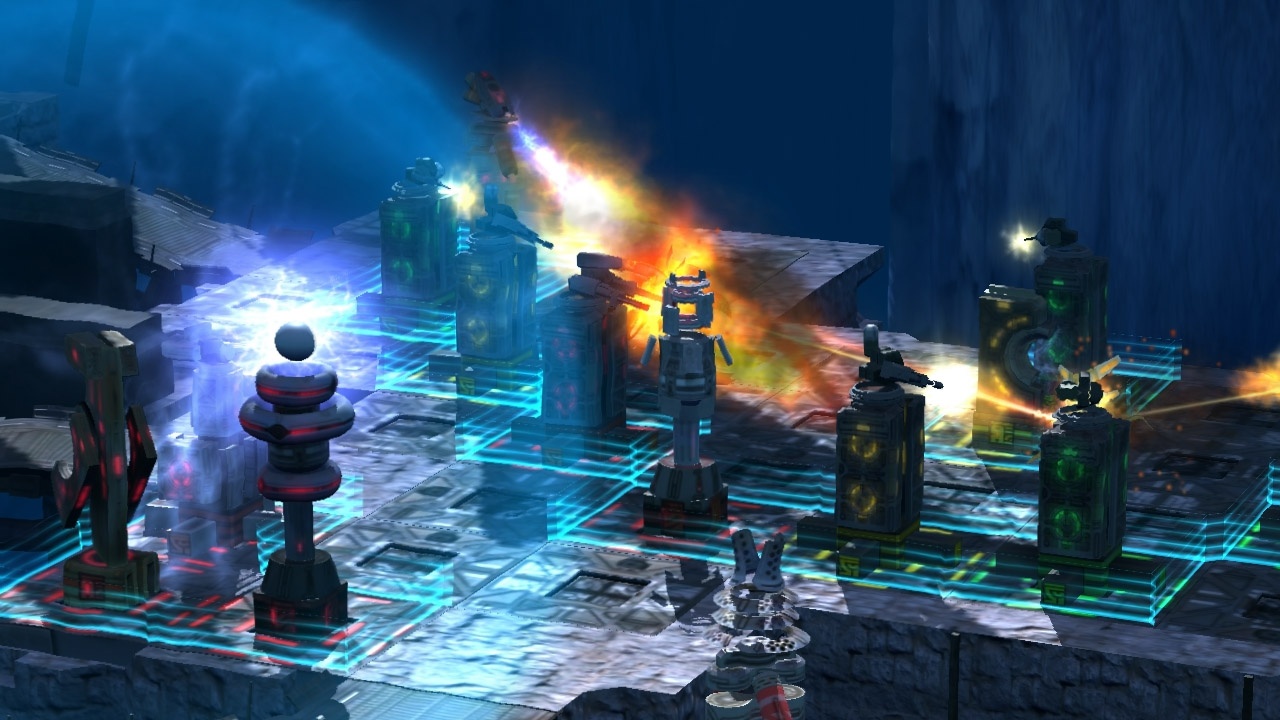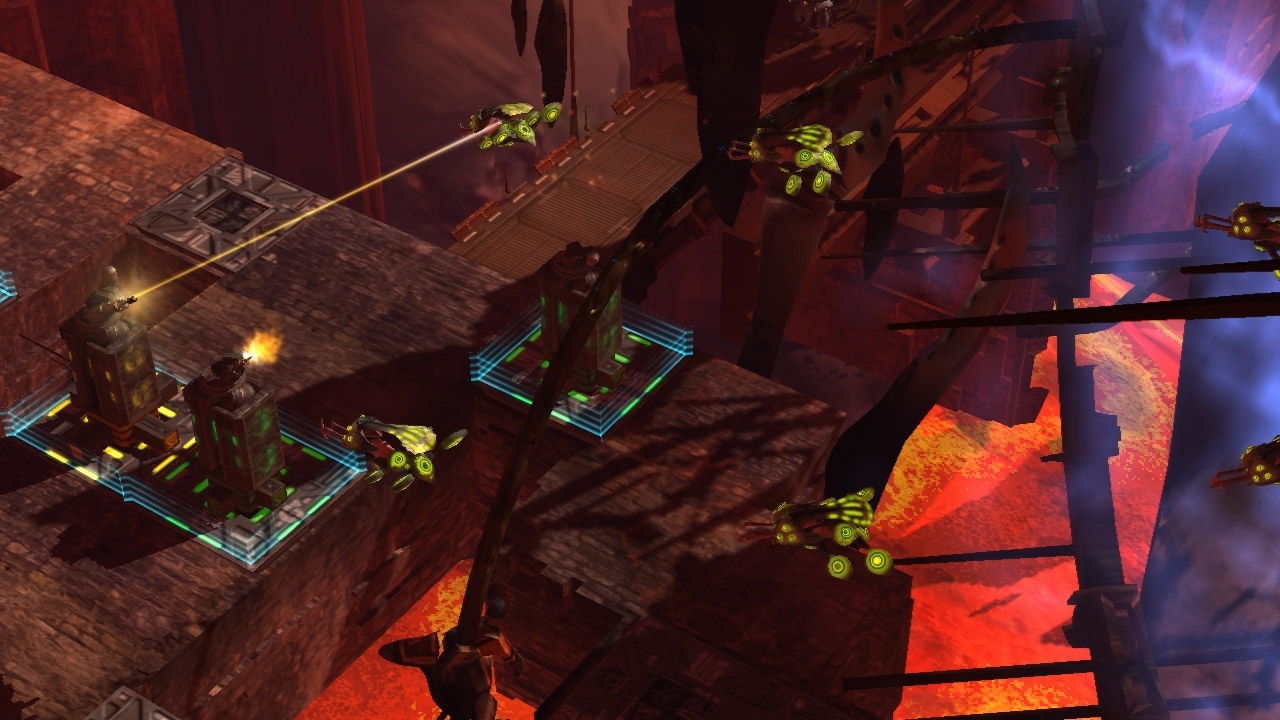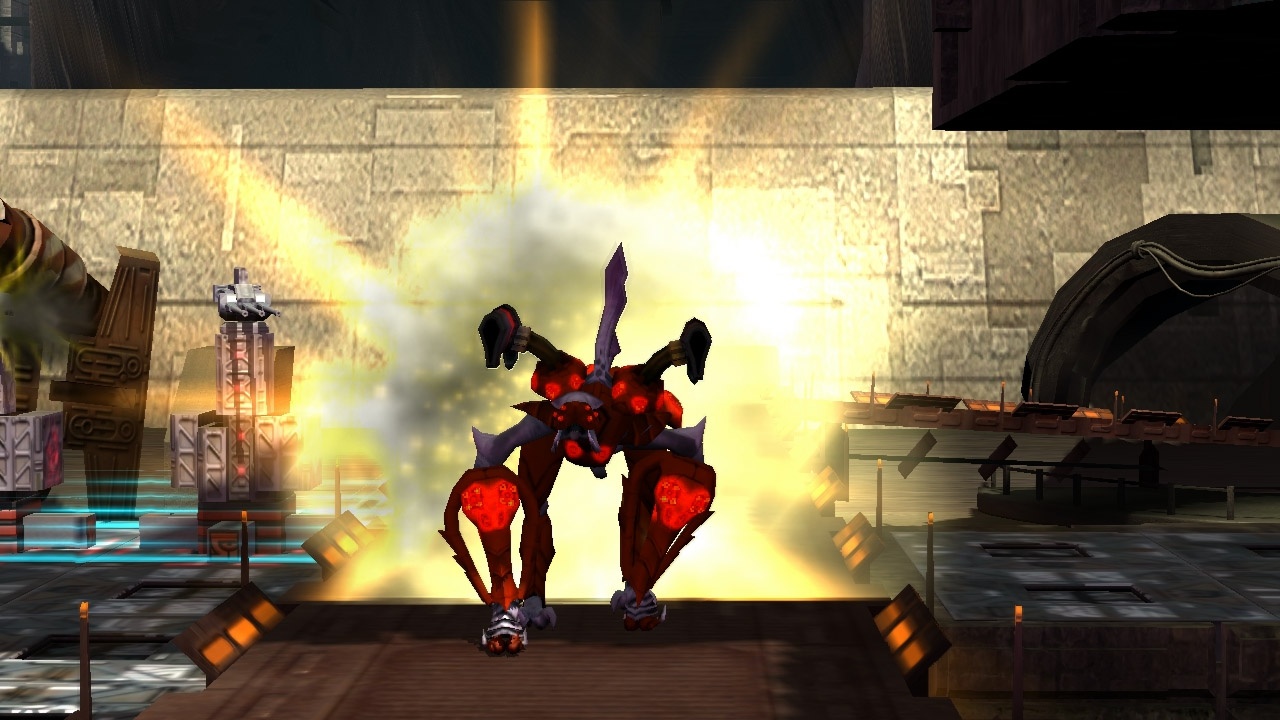Defense Grid: The Awakening is a quintessential example of the tower defense genre. You must defend things, and you build towers to do so. It doesn't try to do anything fancy or innovative with this idea. But this grim alien assault game is of such quality that it will feel like a breath of fresh air to fans of tower defense, and it's so compulsively playable that it's sure to win over many newcomers to the genre, as well.
You're the lucky soul who has stumbled into the task of fending off a massive alien invasion and saving the human race. To stop the aliens once and for all, you'll need the help of a stuffy but genial AI entity left over from the previous war thousands of years ago to activate the planet's ancient defense grid. The plot is pretty typical, but the storytelling is skillful in its subtlety. You rarely get more than an occasional aside from the AI about some haunting memory of the past. Those who don't want a plot getting in the way of slaughtering aliens will find this one nicely ignorable, while those who value such things will find that there's just enough story here to lend the action a sense of desperate importance.
Each map has a cluster of power cores the aliens are bent on stealing, and you must protect them to keep the AI online and, ultimately, activate the defense grid. Your weapons in these battles are powerful, indestructible towers that you place along the aliens' path between their entry point and the power cores. Once placed, your towers attack any aliens in range automatically, freeing you up to, well, place more towers. The aliens are dumb as lemmings, blindly marching into whatever gauntlet of futuristic ordnance you've managed to create as they make their way to your precious power cores. But they more than make up for their idiocy with their sheer number, and their variety. There are small and speedy aliens that dash for the cores; lumbering, heavily armored boss aliens; shielded aliens; flying aliens; and especially obnoxious aliens that carry other aliens inside them. You have a healthy variety of tower types in your arsenal, too, but you'll begin each stage with very limited resources, so you'll need to carefully consider what types of towers to build and where to place them for maximum effectiveness. Each alien is weak against certain attacks, and many of them are well defended against others. It takes a well-rounded defense to fend them all off. You earn resources for killing aliens, but as each stage progresses, the successive waves of attackers get larger and larger, and you'll probably always feel like you have just enough resources at your disposal to fend off the next onslaught.
It's this refined sense of balance that makes Defense Grid compelling, wave after wave. The aliens are powerful, but not unstoppable. You're powerful too, but you must make the most of that power to succeed. This sense of balance keeps the action suspenseful, and it helps that the aliens only rarely stop advancing long enough to let you breathe. You can use these brief respites to spend the resources you've accumulated on purchasing new towers and upgrading existing ones, but you may not want to spend everything you earn in defending against the early waves. The advantage to stockpiling your resources is that you accrue interest over time, so the longer you hold out, the more resources you'll have available to spend. The amount you earn from interest is rarely enough to make or break your ability to defend the cores, but the incentive it adds to try to spend as little as possible early on encourages you to be more strategic in your planning and do more with less.

There's trial and error involved here, to be sure. You may find aliens waltzing practically unscathed through your carefully planned defenses, taking all your power cores and sending you back to the drawing board. But while it can be frustrating to repeatedly fail, this brand of trial and error never feels punishing and is more likely to spur you on to give it yet another go, rather than make you give up. This is not just because you learn from your mistakes and will naturally get better at devising strategies over time; it's also because the game makes it so easy to rewind a bit and try a different tack. Throughout each level, there are periodic checkpoint saves, and at any time you can tap the back button to instantly hop back through those previous checkpoints until you get to where everything started to go wrong. It's a small feature, but it can go a long way toward minimizing frustration.
Defense Grid's campaign takes place across 20 maps that gradually ratchet up the challenge and complexity. Early on, there are relatively few positions available for tower placement. Many later stages, however, are practically covered with viable placement positions, requiring you to place your towers strategically to shape the path the aliens take to the power cores, trying to maximize their exposure to your attacks. The campaign also keeps things interesting throughout by gradually introducing new tower types and upgrades. Your early assortment of standard gun, laser, and flamethrower towers is slowly augmented to include antiair missile towers, electrifying tesla towers, resource-recovering command towers, time-bending towers that slow the aliens within their range to a crawl, and more. Seasoned tower defense players, or those who just have a knack for fighting off alien invasions, will be able to complete the campaign in about six or seven hours. But there's incentive to go back and try to perfect your strategies in the form of medals awarded for completing levels without giving up a single power core, and there are a slew of unlockable challenge modes to boot. The amount of great content you get for your 800 points makes this a pretty good value. It's just too bad that the developers didn't find a way to take this exceptionally balanced gameplay and craft a fun multiplayer mode or two out of it as some other tower defense games have done.

Defense Grid looks really solid for a downloadable game. You can view the action from any of three levels, and while the most intimate perspective reveals the simple textures of the towers and the lack of detail to the aliens, from the loftier vantage points where you'll spend most of your time, it looks much better. It looks its best when all hell is breaking loose, which is most of the time. It's truly satisfying to see the screen erupt with flames, cannon fire, raining meteors, and explosive grenades, and to see the aliens collapsing as they struggle to push through the tremendous force of your defenses. The sound design is equally impactful. Your laser towers sound intense enough to scorch alien flesh, the score is somber and stirring, and the AI unit's voice brings just the right amount of gravitas to the proceedings.
Defense Grid: The Awakening doesn't do anything to advance the tower defense genre. But it doesn't need to. Its elements are so skillfully balanced that those who have already spent plenty of time playing such games are sure to find Defense Grid one of the most rewarding games of its type, while those new to tower defense will find this an accessible introduction to the genre that's easy to get into but very tough to master. This is an alien invasion to be thankful for.
